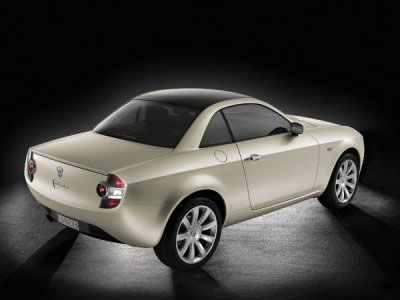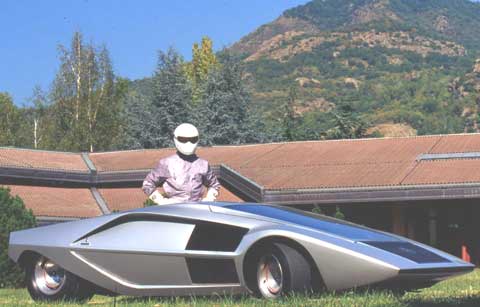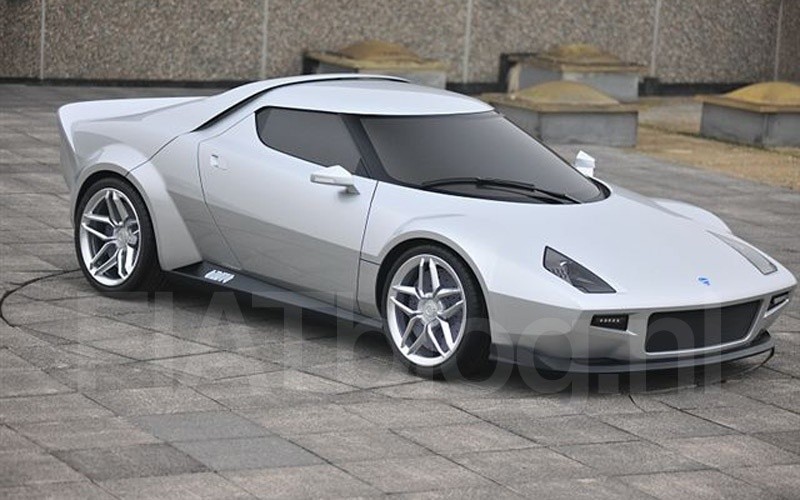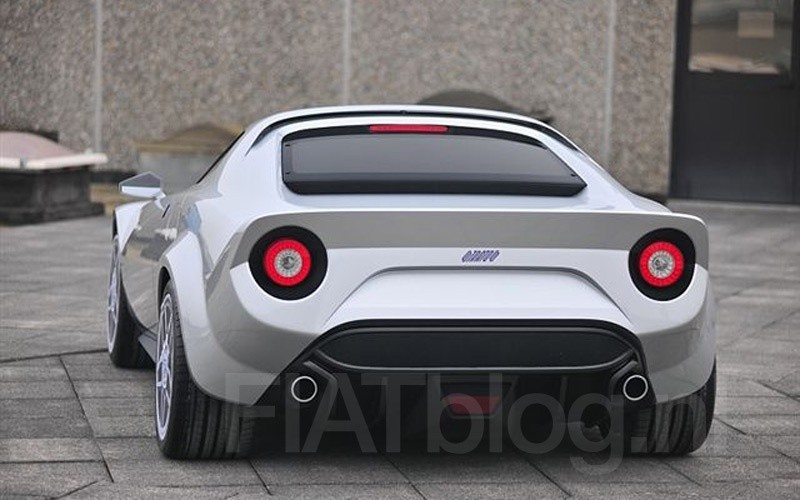LEGEND IS UNCOVERED Less than a fortnight after the story first broke, the dramatic new Lancia Stratos project is revealled today, totally undisguised, the images taken during a testing session at the Balocco circuit, portraying a truly stunning supercar that is every bit in the mould of the iconic and hugely admired original. The three new photos come from German magazine Auto Bild which has also published some further information as more details of this ambitious project, coming almost exactly on the occasion of the fortieth anniversary of the unveiling of the Stratos "Zero" concept, gradually drip out.
Forty years ago the Marcello Gandini-penned, Bertone-stamped "Zero" concept shocked the automotive industry and over the last week-and-a-half this new project has drawn global attention like few Lancias have during the intervening period. We understand that the three images were also taken during this prototype's test session at the Fiat Group's Balocco test track near Milan on June 21 (as were the two grainy shots we published last week) but more information on that test has now emerged, including that the test driver on the day was former F1 pilot Tiago Monteiro, and that the test was adjudged a huge success.
From that "Zero" show car of 1970, and then the new-from-the-ground-up Stratos HF Prototipo (1971), the legendary production Stratos was born, again crafted by Bertone, and with the supercar destined primarily for competition use, 500 examples had to be built to satisfy homologation requirements. Lancia never kept accurate build records but 492 units is the accepted production figure.
Now it is fast forward four decades. More detailed information on the new project has been revealled today, most sensationally that the new Stratos is powered by a production Ferrari V8 engine and this provides one of the biggest pointers yet to the keen adherence to history of this project as the original Stratos was fitted for production with the Ferrari "Dino" V6 engine. The apparent use of Ferrari 599 GTB Fiorano-drawn rear light units on the prototype at Balocco adds to the sourcing of Maranello components along with the CCM brake units that may well also be a Ferrari item.
For the first time the rear of the car has been glimpsed and here the design language is once again firmly in the Stratos mould with the single round light units, a body-moulded jutting spoiler, moulded registration plate recess, and twin exhaust outlets that now exit on either side of a modern-day integrated rear aerodynamic-inducing splitter section. The rear end of the supercar also gets an integrated high-level brake light and a neatly-executed design around the fitting of the rear window which is part of the enveloping clamshell.
This careful adherence to Lancia tradition complements other similarly inspired cues on the car such as the distinct curves of the side windows' outline shape, the large front radiator grille and positioning of the indicators (although they are now LED units). The passing of time has seen the original's "pop-up" headlights outlawed but the new units have been well thought out and almost mimic that "flap" cue and at the base very slightly dig into the bodywork. The prototype's wheels are also a distinct reinterpretation of the original Stratos' rally wheels (they were most famously finished in "yellow" on the factory rally cars) most notably they are now twin spoked whereas the spokes were solid on the original which had to withstand the constant crushing impact of tough rally stages. The wheels' single central locking hub nut arrangement can be seen on the prototype and is yet another thoroughly modern feature that has been crafted in. More modernity can be seen in the aerodynamic front spoiler which separates the car from the original and the interesting positioning of the fog lamp units. The prototype also shows a clear front cover recess for the "Lancia" badge.
All the "visible" bodywork components of the car are in carbon-fibre, the "clamshells" (which appear from the images to open exactly as they did on the original model), doors and other body panels, while the extremely-high level of finish implies that these have been taken directly from moulds, lending weight to information that the car is destined for a limited production run. Italiaspeed also understands that this is one of several prototypes that have been completed so far, possibly as many as five have been built, and this ties in with a project that has seen at least three full-size mock-up models created as three Italian design houses fought over the brief.
Apparently the Stratos prototype was "sensational" during this test programme at the demanding Balocco proving ground, considerably exceeding the benchmarks put down for the day's test in every area, not least the handling of this lightweight and short wheel base car. The adherence to the original Stratos' philosophy of being designed as a competition car first and foremost, and therefore minimalism and weight saving were key objectives of Bertone's design team four decades ago, can be seen in the very clean and simple door catch design while the lock barrel is located several inches away.
Italiaspeed also understands that the original car's legendary "helmet pocket" feature has been carried over to the new car, so a crisp, racing-style cockpit can also be expected. The results of the test and the information so far all adds weight to a project that appears to have been in the development stage for around four years, and by the parameters involved, has been firmly in the "money no object" category.
The rebirth of the Stratos comes after many major milestones in the forty-year history of the much-loved sports car, which kicked off in 1970 with the development of the Stratos HF Prototipo, a car that made its world debut at the Geneva Motor Show in 1971, while the Lancia Stratos HF Stradale arrived in 1975. That car came, saw, stunned and conquered before being consigned to the pages of history. Then there was more than a two decade gap before, and almost fittingly, eccentric and outrageous Swiss stylist Franco Sbarro reinterpreted the iconic sports car with his "Ionos" concept which debuted at the Geneva Motor Show in 1997. Italian design and engineering company Stola unveiled its "S81", a thoroughly modern reinterpretation of the Stratos, at the Turin Motor Show in 2000. Five years later leading Stratos collector Chris Hrabalek unveiled the "New Stratos" concept, developed by his Fenomenon design company, at the 2005 Geneva Motor Show. 2010 is the 40th anniversary of the Stratos.
We can also clarify our story earlier this week that former Pininfarina and Bertone designer, and now design chief at newly revitalised Saab, Jason Castriota, one of the world's top automotive designers responsible for the Maserati Birdcage 75th and Maserati GranTurismo amongst others, was responsible for the design of the new Stratos. In fact we can confirm that Castriota was involved during the earlier gestation stages of the project but that involvement has long since ceased.




(vir:
http://www.italiaspeed.com/2010/cars/la ... /1308.html)


















